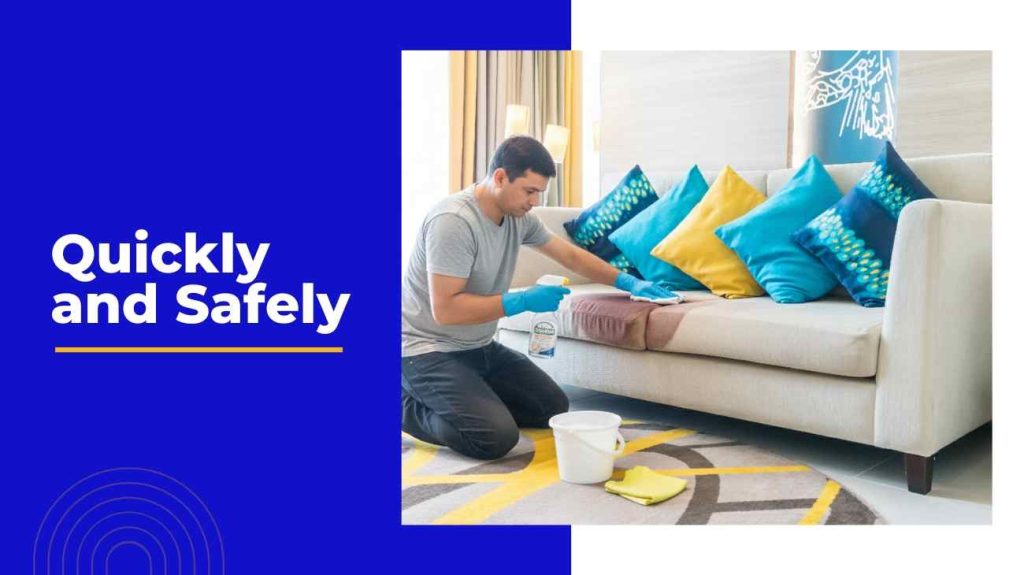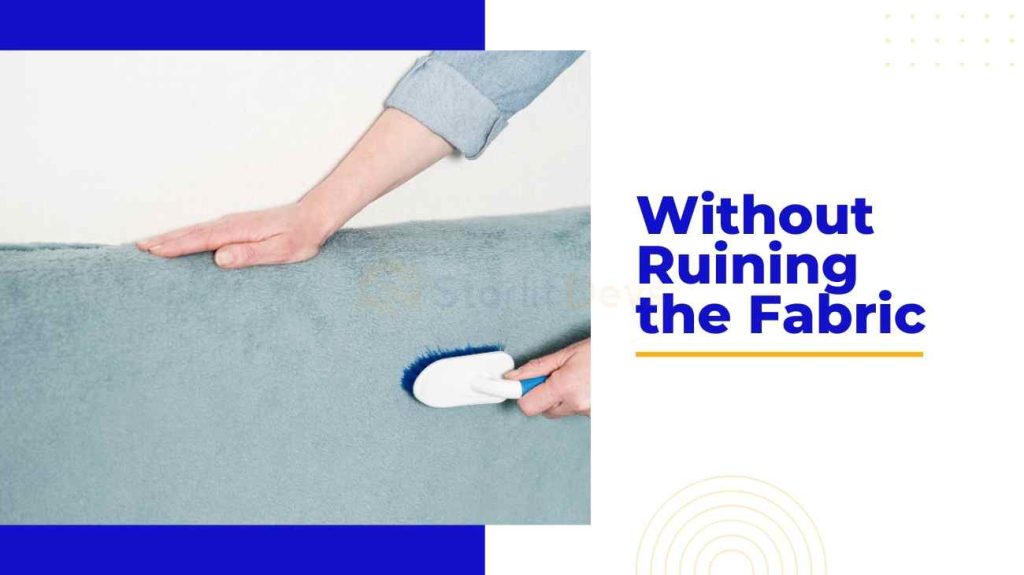Blood stains on your favorite sofa or bean bag are a common occurrence. Accidents happen all the time. A small cut, a nosebleed, or even a scraped knee can quickly leave a spot on your favorite seat. The key is to act fast and use the right cleaning method before the stain has a chance to set. Cold water works best, since hot water can lock the blood into the fabric.
Blood stains can be tough to deal with, especially if they’ve had time to dry. They don’t just leave an ugly mark, they can also sink deep into fabric fibers and feel impossible to lift. Learning how to remove blood from upholstery doesn’t need to be complicated. With the right steps, you can treat both fresh and set-in stains without ruining your couch or chair.
Simple household items can do the job. Items such as mild dish soap, salt, baking soda, or hydrogen peroxide can help loosen and lift the stain. Always test on a hidden spot first to make sure the fabric won’t discolor. If the stain refuses to come out or the fabric is delicate, it may be time to call a professional cleaner.

How to Remove Blood from Upholstery Quickly and Safely
Blood stains on upholstery can be stubborn, but they’re not impossible to deal with. The secret is to act fast, use cold water, and choose the right method for the fabric.
Knowing how to remove blood from upholstery helps prevent the stain from setting and keeps your furniture looking clean.
Blotting comes first. Always dab the stain with a clean cloth or paper towel to lift as much blood as you can. Never rub. Rubbing forces the stain deeper into the fibers and makes it harder to remove. Continue gently blotting until the cloth comes away cleaner.
Cold water is the next step. Flush the area with cold water or dampen a cloth and press it into the stain. Hot water is a mistake—it will lock the blood into the fabric. Cold water loosens the stain, allowing it to be lifted in the following steps.
Club soda works well on fresh stains. Pour a little directly on the spot and let it fizz. This action helps break down the blood. Blot again with a cloth, repeating a few times if needed. You’ll notice the stain lightening as the soda lifts it out.
A mild dish soap mix is another safe option. Stir one teaspoon of liquid dish soap into two cups of cold water. Dip a cloth into the solution and dab the stain. You should see the stain transfer onto the fabric as you work. Keep blotting with fresh parts of the cloth until the spot fades.
Rinse the fabric to remove any leftover soap. Dampen a clean cloth with cold water and blot the area again. Once the stain is gone, press a dry towel onto the fabric to soak up extra moisture.
Let the upholstery air dry naturally for the best results.
For tougher or older stains, a stronger cleaner may be needed. Enzyme-based sprays or pre-treatment products break down proteins in blood, making removal easier. Apply as directed, let it sit, then blot and rinse as before. Always test on a hidden area first to be sure it won’t damage your fabric.

How to Remove Blood from Upholstery Without Ruining the Fabric
Blood stains can be tough to deal with, especially on couches and chairs that you can’t just toss in the wash. The proteins in blood latch onto fabric fibers and harden as they dry, which makes them cling even tighter.
That’s why acting fast is key.
But even if the stain has dried, you can still make progress with the right approach. Learning how to remove blood from upholstery is about timing, patience, and using the right steps without damaging the fabric.
Fresh stains are the easiest to treat. Start by dabbing with a cloth dipped in cold water. Never use hot water, since heat locks the stain in. Work gently and blot rather than rub, so you don’t spread it deeper into the fabric. Keep swapping to a clean section of cloth until the stain lightens.
Dried stains take more work. First, scrape off any crusty bits with a dull edge. Then use cold water to loosen what’s left. You may need to apply a mild soap or an upholstery cleaner and blot slowly. Don’t rush it—lifting old blood takes time. With patience, even set stains can fade without harming the fabric.

How To Remove Dried Blood From Upholstery
Dried blood looks stubborn, but it’s not impossible to remove. The key is to loosen the dried blood first, then use a cleaning method that’s safe for your type of fabric.
Follow these steps to remove dried blood from your sofa or chair easily without damaging the fabric.
- Loosen the dried blood first
Start by gently scraping the crusted blood with a soft brush or the edge of a dull knife. Vacuum up the flakes so they don’t smear when you start cleaning. Removing the loose bits first makes the next steps much easier and more effective.
- Hydrogen peroxide for light fabrics
Hydrogen peroxide works well on white or very light upholstery. Dab the stain with a cotton swab or cloth soaked in 3% hydrogen peroxide. Let it fizz for about 30 seconds, then blot with a clean cloth. Repeat if necessary, and always rinse with cold water afterwards. Test a hidden spot first, as peroxide can bleach some fabrics.
- Gentle cleaning for most fabrics
For colored or delicate fabrics, try a mix of cold water, glycerin, and mild detergent. Combine 80% water, 10% glycerin, and 10% detergent in a spray bottle. Lightly mist the stain, wait five minutes, blot with a white cloth, rinse with a damp sponge, and pat dry. You might need to repeat a few times, especially for older stains, but this method is gentle and safe.

Tips on How To Prevent Future Stains On Your Upholstery
Learning how to remove blood from upholstery doesn’t have to be stressful. By checking the care tag, handling stains gently, and protecting your fabric ahead of time, you can keep your furniture looking fresh and clean.
- If blood spills, act fast. Blot the area with a cold, damp cloth immediately. Avoid hot water, as it can set the stain permanently. Quick action keeps your upholstery looking clean and makes removal much easier.
- Check the care tag before cleaning. It tells you what your upholstery can handle. Water-safe fabrics can take water-based cleaners, solvent-safe fabrics need special cleaners, and some materials should only be vacuumed or treated by a professional. Following these codes protects your furniture from fading or damage.
- Never use hot water or scrub the stain. Heat sets blood, and scrubbing pushes it deeper into the fibers. Instead, blot gently with a clean cloth to lift the stain without spreading it.
- Use the right cloths and the right amount of liquid. Avoid colored cloths that can bleed dye onto your fabric, and don’t soak the area. Too much moisture can lead to mold or leave watermarks.
- Prevent stains whenever you can. Fabric protectors and throw rugs in busy spots make cleanup easier. Treat any blood stains quickly to stop them from becoming permanent.
- Always proceed with caution when using household remedies. Baking soda, saltwater, and vinegar are often suggested, but they can be risky. Some may damage fibers, fade colors, or leave a residue that attracts dirt. In some cases, they can even make the stain harder to remove. Stick with tried-and-true cleaning solutions for the best results.

FAQs: How to Remove Blood from Upholstery
Can I use hydrogen peroxide on my fabric couch?
Yes, hydrogen peroxide can be helpful when trying to remove blood stains from light-colored or white upholstery. Make sure your couch’s care tag says W or W/S. Hydrogen peroxide can bleach darker fabrics, so always do a small spot test in an inconspicuous area before applying it to the whole stain.
What’s the quickest way to remove fresh blood?
Acting fast is the fastest way if you want to know how to remove blood from upholstery. The second fastest way to remove blood from upholstery is by blotting it with cold water. Using club soda or a mild dish soap solution can also help lift the stain before it sets. The key is to avoid rubbing the stain, as this can push it deeper into the fabric.
Does vinegar help remove blood stains?
Vinegar can work, especially on fresh stains. Its acidic nature helps break down blood proteins. Dilute white vinegar with water and gently blot the stain. Always test it on a hidden area first to make sure it won’t damage the fabric.
Can salt remove blood from upholstery?
Yes! Salt can act as a natural stain remover. Make a paste using cold water and salt, spread it over the stain, and let it sit for about 30 minutes. Then rinse with cold water and blot dry. This can help lift the stain without harsh chemicals.
Are old blood stains permanent?
Old blood stains can be tricky. If they’ve been washed in hot water or gone through the dryer, the stain may be permanent. But even in tough cases, applying cold water, mild soap, or hydrogen peroxide can help lighten the stain and make it less noticeable.
How to remove blood from specific items like a mattress?
For a mattress, a simple baking soda solution works well. Mix one part baking soda with two parts cold water, apply to the stain, let it sit for 30 minutes, then blot with a cold water-soaked rag. Finish by dabbing dry and letting it air dry.
What if my furniture tag says ‘X’?
If your upholstery has an X on the care tag, it shouldn’t be cleaned with water or solvents. In this case, vacuuming or hiring a professional cleaner is the safest option to avoid damaging the fabric.






